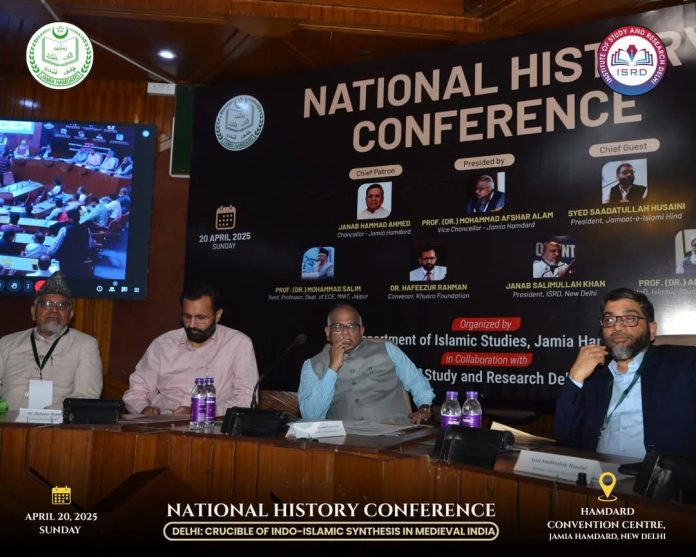History as a Bridge, Not a Weapon: Muslims Defend India’s Shared Heritage
– Mohamed Talha Siddi Bapa
At a time when communal rhetoric is on the rise, and history is being distorted for political mileage, India is witnessing two starkly different approaches to the nation’s past and future. On one side, we have rising efforts to polarise communities, especially by targeting the legacy of Muslim rulers. On the other, India’s Muslim community continues to respond not with retaliation, but with resolve – channelling their energy into scholarship, community service, and constructive dialogue.
The recent National Conference on the Indo-Islamic Synthesis in Medieval India, held at Jamia Hamdard in collaboration with the Institute of Study and Research Delhi (ISRD), is an important case in point. The event brought together over 50 scholars and students from premier institutions including JNU, AMU, Jamia Millia Islamia, and MANUU to present a nuanced, evidence-based picture of India’s shared civilizational journey, with a focus on Delhi’s historical role as a centre of cultural fusion.
The timing of this academic initiative is crucial. In states like Maharashtra, Uttar Pradesh, and Assam, there appears to be an emerging pattern of politicising history – most notably seen in the controversy around Aurangzeb’s grave in Khuldabad, Maharashtra. A site that had long remained a quiet symbol of historical interest is now being used to stoke communal passions and reignite centuries-old grievances. These selective interpretations of history are aimed less at the past and more at influencing the present electoral landscape.
However, as President of Jamaat-e-Islami Hind Syed Sadatullah Husaini rightly noted during his keynote at the conference:
“Muslims in India are not outsiders or invaders, but contributors to its intellectual, cultural, and social development.”
The Delhi Sultanate and subsequent Muslim rule, as discussed in the conference, cannot be painted in monochrome. Scholars highlighted the architectural innovation, urban planning, educational reforms, and administrative systems that emerged under these regimes. Far from being solely defined by conquest, medieval India under Muslim rulers was marked by a complex process of integration and evolution – where ideas, languages, and spiritual traditions merged into what we know today as Indian civilization.
Importantly, the conference didn’t ignore difficult chapters of history but urged a contextual understanding grounded in facts rather than sensationalism. One paper detailed the inclusive policies of Muhammad bin Tughlaq, while another explored the multi-faith patronage under the Lodhi dynasty. Others reflected on how Sufi institutions served the marginalised, often acting as centres of relief and intercommunal support.
This academic initiative is part of a wider pattern. In contrast to the divisive political narrative, Indian Muslims continue to engage in meaningful public service and interfaith efforts – often under-reported in the mainstream discourse.
A striking example of this was during the recent stampede at the Kumbh Mela in Prayagraj. According to eyewitness accounts and local media reports, many Muslim households and Masjids in nearby areas opened their doors to Hindu pilgrims, offering water, food, shelter, and medical assistance to the affected. Volunteers from local madrasas and Muslim welfare groups were seen distributing first-aid kits and ferrying injured pilgrims to hospitals.
One resident of Kareli, Mohammad Salman, who turned his house into a temporary relief shelter, told reporters:
“It doesn’t matter who is in trouble. Our religion teaches us that serving fellow human beings is the highest form of worship.”
Similarly, Masjid Noorani, located near the banks of the Sangam, functioned as an informal care centre for women and elderly pilgrims who were separated from their families. These acts of compassion were not organised by large institutions, but by ordinary citizens acting on conscience.
These contrasting images – one of political leaders invoking medieval conflict for votes, and the other of citizens crossing religious lines to offer help – raise a fundamental question: Who truly represents the spirit of India?
The same humanitarian spirit was witnessed during the COVID-19 pandemic, when fear and misinformation often ran rampant. In cities across India, Muslim organisations and individuals arranged for funerals of those abandoned by their families, irrespective of religion. Community kitchens were set up in Masjids, and volunteers distributed ration kits, cooked food, oxygen cylinders, and medicines to anyone in need. In several places, Masjids turned into round-the-clock relief centers – serving humanity, not just faith.
These actions speak louder than the toxic noise of TV debates. They remind us that India’s Muslims are not just reacting to prejudice – they are actively building an inclusive future, grounded in their values and conscience.
Is it those who seek to divide us by digging up graves and renaming cities, or those who seek to build understanding through education and service?
The answer becomes more evident when viewed through the lens of history itself. Communal harmony in India has never been perfect, but it has survived centuries precisely because people chose coexistence over confrontation. As the idiom goes, “fire can’t be extinguished with kerosene.” Hate cannot be neutralised by more hate. It is compassion, dialogue, and shared struggle that douse the flames.
While efforts to demonise Muslim history gain political traction, it is important to ask: what purpose does this serve? Whose problems are solved by rebranding Aurangzeb’s grave or rewriting school textbooks? On the ground, citizens are grappling with inflation, unemployment, a healthcare crisis, and growing inequality. In this context, communal polarisation serves as a distraction – a short-term tactic for long-term social fragmentation.
The Muslim community’s approach offers an alternative national vision: a focus on positive contribution rather than reactive confrontation. Whether through organising food distribution drives, preserving historical truth, or offering shelter in a moment of stampede-induced panic, these actions reflect a quiet patriotism rooted in dignity and shared destiny.
India is a vast and diverse country where elections – whether local, state, or national – are a near-constant feature of public life. In this charged political environment, the choice before the nation is not just electoral, but moral. Do we want to be a society that weaponizes the past to fracture the present? Or do we wish to honour our collective legacy by upholding truth, compassion, and justice? The question remains: Whose approach will ultimately win the hearts of the people – those who spread hate for electoral benefit, or those who heal and serve, even in the face of vilification?
The answer, perhaps, lies not in rhetoric but in the streets of Prayagraj, the halls of Jamia Hamdard, and the hearts of those who still believe in an inclusive India.




